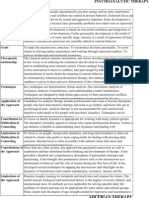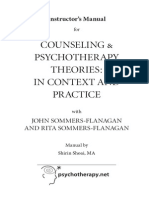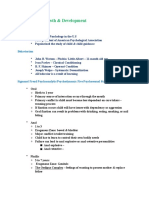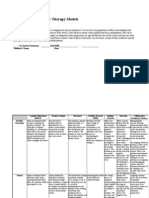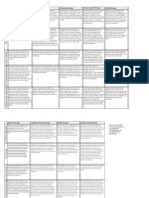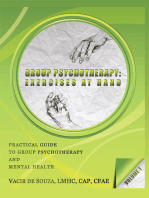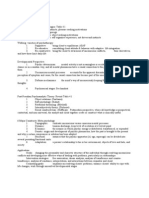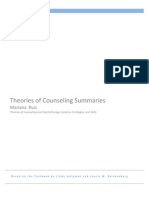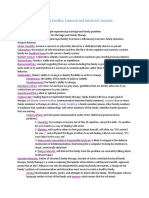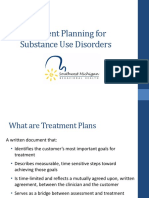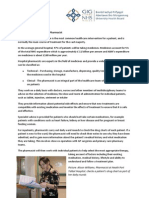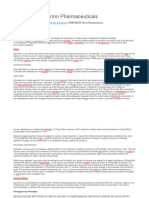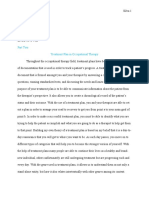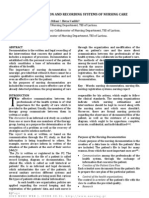100%(1)100% found this document useful (1 vote)
NCE STUDY NOTES - Group Therapy
Uploaded by
Mimi Davidson McKinneyThis document summarizes the history and key concepts of group therapy. It discusses how group therapy emerged in the early 20th century through the work of psychodrama pioneers like Jacon Moreno and the formation of early professional organizations. Key concepts covered include types of groups like counseling vs psychotherapy groups, group norms, processes, cohesiveness, leadership styles, and risks/ethics. The document provides definitions and examples of important group therapy terms and models.
Copyright:
© All Rights Reserved
Available Formats
Download as DOCX, PDF, TXT or read online from Scribd
Download as docx, pdf, or txt
NCE STUDY NOTES - Group Therapy
Uploaded by
Mimi Davidson McKinney100%(1)100% found this document useful (1 vote)
This document summarizes the history and key concepts of group therapy. It discusses how group therapy emerged in the early 20th century through the work of psychodrama pioneers like Jacon Moreno and the formation of early professional organizations. Key concepts covered include types of groups like counseling vs psychotherapy groups, group norms, processes, cohesiveness, leadership styles, and risks/ethics. The document provides definitions and examples of important group therapy terms and models.
Copyright
© © All Rights Reserved
Available Formats
DOCX, PDF, TXT or read online from Scribd
Share this document
Read this document in other languages
Did you find this document useful?
Is this content inappropriate?
This document summarizes the history and key concepts of group therapy. It discusses how group therapy emerged in the early 20th century through the work of psychodrama pioneers like Jacon Moreno and the formation of early professional organizations. Key concepts covered include types of groups like counseling vs psychotherapy groups, group norms, processes, cohesiveness, leadership styles, and risks/ethics. The document provides definitions and examples of important group therapy terms and models.
Copyright:
© All Rights Reserved
Available Formats
Download as DOCX, PDF, TXT or read online from Scribd
Download as docx, pdf, or txt
100%(1)100% found this document useful (1 vote)
NCE STUDY NOTES - Group Therapy
Uploaded by
Mimi Davidson McKinneyThis document summarizes the history and key concepts of group therapy. It discusses how group therapy emerged in the early 20th century through the work of psychodrama pioneers like Jacon Moreno and the formation of early professional organizations. Key concepts covered include types of groups like counseling vs psychotherapy groups, group norms, processes, cohesiveness, leadership styles, and risks/ethics. The document provides definitions and examples of important group therapy terms and models.
Copyright:
© All Rights Reserved
Available Formats
Download as DOCX, PDF, TXT or read online from Scribd
Download as docx, pdf, or txt
You are on page 1/ 7
Groups:
Dyadic Relationship: two functioning as a pair (counselor/therapist)
Group: a membership which can be defined, some degree of unity and interaction, a shared
purpose.
Jacon Moreno (Father of psychodrama):
-coined the term group therapy in 1931
-In psychodrama client expresses spontaneous feelings via role-playing
Joseph H. Pratt: Formed first groups 1905-1923
American Society for Group Psychotherapy and Psychodrama (ASGP) and the American Group
Psychotherapy Association (AGPA): 1940’s organizations for group therapy were created.
Adler: Prefaced group therapy, group tmt in 1920’s at child guidance facilities in Vienna.
Gerald Caplan (Pioneer in crisis intervention movement):
Primary: preventative and attempt to ward off problems, stresses a healthy lifestyle or
coping strategies which can reduce the occurrence of a given difficulty. Ex: a group that
teaches birth control to prevent teen pregnancy.
Secondary: a problem or disturbance is present but not usually severe, works to reduce
the severity or length of a problem and generally includes aspects of prevention. Ex:
group for grief or shyness
Tertiary: Deals more with individual difficulties that are more serious and longstanding,
long-term psychotherapy and always focused on the client’s childhood. More likely to
deal with severe pathology
Group Norms: govern exceptable behavior and group rules. Explicit and implicit (not verbalized)
rules which tell group members how to behave and how not to behave in a given situation.
“expected behaviors”
Group therapy initially flourished in the US due to the shortage of individual therapists during
WWII.
-severe psychological problems, supply and demand
Group Content: refers to material discussed in a group setting
Group Process: refers to the manner in which discussions and transactions occur. Analyzing the
communication, interactions and transactions. The way that the discussion takes place.
T-Group (“T” Training): Training group, used in industrial and organizational settings to process
personal interactions and improve efficiency. Stress ways employees can express themselves in
an effective manner. (Leland Bradford, Kenneth Benne and Ronald Lippett).
Cohesiveness: Forces which tend to bind group members together. A sense of caring for the
group and other group members.
Kurt Lewin’s “Field Therapy”: Cohesiveness = “positive valence”
-When cohesivness goes up, negative factors go down
-High cohesiveness leads to leads to high group productivity and commitment
-Little to no cohesiveness = “fragmented”
Group therapy, personality reconstruction group, is of longer duration than group counseling.
George Gaza: (3 distinctive groups)
1. Guidance (effective eduction group or psychological education group or
psychoeducational group): primary group, mainly preventative, originated in the
public school system, do not deal with remediation of severe psychological
pathology, provide instruction about a potential problem ex drug abuse or
improving study skills, time limited and use videos/guest speakers to enhance
experience.
2. Counseling: In individual therapy, counseling and therapy are interchangable. In
group, therapy implies that the problem is more severe and more individual work is
neededfor a longer duration. Counseling group would not tend to be psychodynamic
and would focus primarily on conscious concerns. Less structure than guidance
group, leader needs more training than leader of guidance group due to possibly
having to treat people who are not functioning at normality.
3. Psychotherapy: commonly used at inpatiant psychiatric hospitals and residential
facilities for patients with in-depth psychological problems . Tertiary and may
emphasive the role of the unconcious mind and childhood experiences more than a
counseling group.
Structured exercises:
-less effective than unstructured techniques.
-Can help speed up group interactions
-Yalom states that structured exercises can creat a situation where group stages are
passed over.
-Makes clients purge feelings too rapidly when members are not emotionally equipped
to handle this
-Can make the group rely too stongly on the leader for support/direction
-Group exercises must correspond to the level of group development
Disadvantage of group, individual issues are not properly examined.
Risky Shirt phenomenon: a group decision will be less conservative than the average group
member’s decision, prior to group discussion.
Group Polarity or Group Polarization: Predicts a person’s views may become more extreme
after they participate in a group.
Self-Help/Support Group: group of people who are all attmepting to cope with a given issue
(alcoholism, gambling addiction, weight control). Members have a common goal or problem
and learn from each other. Voluntary.
Marathon Group (Frederick Stoller/George Bach): after an extended period of time defenses
and facades will drop and the person can become honest., genuine and real. Lasts 24 hours.
(weekend, several days)
-Support group: is conducted by an organization (AA, weight watchers) and might
charge fees
-Self-Help Group: would not have either or both of these features ex; neighbors coming
together to discuss plan to clean up after a flood).
Screening:
-recommended for all groups, determines who is appropriate or not for a given group,
membership of a group can determine success or failure of group
-Clients who are very verbal, open to feedback from others, and believe in group
therapy often make excellent group members.
-Pre-group interview recommended for screening and orientation
-Yalom states main factor in selecting participants is that members can feel cohesive
(Sense of we-ness), high denial, low motivation and low intelligence are associated with
premature termination from group therapy.
Open Group: Allowing new members to join at anytime, more stable, 6 leave = 6 replaced,
member who begins after the beginning of group will have missed experiences or info
Closed Group: Allow no new members after the group begins, promotes cohesiveness, clients
can drop out and will not be replaced, less cost effective
Homogeneity “Homogeneous”: Members are very similar or alike, greater degree of “we-ness”
or cohesiveness, desireable same intelligence and level of deveopment,
Heterogeneity: members who are dissimilar, ex: clients with various probems and backgrounds
Leadership Styles (3 Basic) Lewin, Lippett and White:
1. Autocratic (Authoritarian): Hostility 30X’s greater, best when an immediate decision
needs to be made,
2. Democratic: Member satisfication is the highest, not high productivity, most desirable
3. Laissez Faire: Group members can do what they want without leader interference or
direction, best after a decision has been made and group is committed to it
---Charismatic leadership style: Leader uses personal power, charisma, and
attractiveness to abet facilitation
Effective leaders have discovered that modeling appropriate behaviors improves group
paticipation, even when the members are resistant.
Speculative Leaders: Focus on the here and now
Coleadership (Corey, Corey): more than one leader, group can go on even if one group member
is absent, two leaders can focus on group dynamics better than one leader, leaders can process
feelings between sessions, supply more feedback to group members, they can learn from each
other and can model effetive communication for the group, reduces burnout and helps ensure
safety, best when leaders have similar philosophy and group style, sit on opposite sides of the
room, helpful when one leader is experiencing countertransferance
Countertransference: Counselor has issues that are interfering with the treatment proces
Transference: refers to a client’s issue
Coleaders: Meet between group sessions so as to not work cross-purposes
Corey: participation in a therapeutic group and participation in a leader’s group (even if the
individual is well-educted and is licesned and certified).
Ideal group size: 5 or 6 to 8 (adult), 5 or 6 (adolecent) group that is over a long period of time
can do 10 members, 3-4 (children)
Group Length: 2 hours even with critical issues (adult) children shorter session more frequency.
Group Risks: An ethical leader will discuss them during the initial session with a client. Cannot
guarantee confidentiality. The group leader will attempt to safeguard client’s against risks and
work to reduce risks and dangers.
Informed Consent: purpose of the group, the risks involved, and the leaders qualifications.
Occurs during the screening process before the initial group session.
ASGW has ethical guidelines for groups
Group leaders should inform members that participation is voluntary and they may exit the
group at any time.
Ground rules: when ground rules become standard these are now called norms
Ambivalent Transference: psychoanyalitic notion often thrown out in multicultural circles which
suggests that a client will treat a therapist with ambivilence as he or she would any person
viewed as an authority figure. Clinet will experience contradictory emotions, such as love and
hate, alternating from one to the other.
Blocking: Occurs when a leader uses an intervention to stop or block a negative or
counterproductive behavior which could hurt another member or the group.
Scapgoating: members gang up on a single group member.
Group Dynamics: the study of group operations, interrationships and interactions between
group members. (group stages, cohesiveness, leadership style, and decision making.
Hot seat technique: Fritz Perls/Gestalt therapy A person who is the target of the therapists
interventions in the here-and-now is said to be on the “hot seat”
Group Unity: a feeling of belonging, oneness, or togetherness.
Sociogram: a pictorial account of a group which serves to diagram member interaction.
Karpman’s drama triangle: Transactional Analysis, teaching device to iluminate the roles of
persecutor, rescuer, and victim in interpersonal relationships.
The energizer: stimulates enthusiasm in the group.
The scapegoat: the person everybody blames. The target of severe anger or hostility.
The Gatekeeper: does not work on his own personal issues, secretly wishing that they were
running the group
The Interrogator: group members who insists on askig other members inappropraite questiongs
“peeping Tom”
The Follower: goes along with the rest of the group, nonassertive.
Relex Therapy (Andrew Salter): extinction or the practice of spontaneously experiencing and
expressing true emotions (even negative ones) is seen as necessary in order to attain a state of
positive mental health.
The Haromonizer: person who tries to make certain that everything is going smoothly.
The storyteller: monopolizes a wealth of the group time telling endless (often irrelevant) tales.
Isolate Role: is ignored by others, afraid to reach out or do reach out and are genuinely rejected
Member Roles:
Task Roles: help solve problems, aid in terms of goal setting and keep the group focused
and are seen as positive. An info giver helps the group carry out a task.
Maintenance Role: Maintain or strengthen group processes. Positive role.
Self-serving (individual) role: Seen as a negative. The person falls into this category
meets his own “individual needs” at the expense of the group. Ex: refuses to participate
or critisizes others. Works against the group.
An entire group could be classified as a task group or perhaps a task/work group. A group of
this nature focuses on accomplishing work goals. According to former ACA president, textbook
author, and group expert Sam Gladding, an athletic team would fall into this category, as would
a quality circle employee run group attempting to improve business.
Role Conflict: a situation in which there is a discrepency between the way a member is
expected to behave and the way he is actually behaving.
Group development: theories of group stages
1. Initial Stage “orientation and exploration” “preaffiliation” “forming”: Approach-
Avoidance ex: attracted and repelled by the same goal. Members feel the most
suspicious.
2. Transition Stage “power and control” “Storming”: the group stage which occurs after
the first initial stage. The initial stage group members get acquanted and learn
norms. In the transition stage members are often judgemental, resistant, or involved
in a struggle for power to establish a hierachy or “pecking order”. Rebellion against
leader.
3. Working Stage “norming stage” “cohesion stage” “negotiation, intimacy and frame
of reference”
4. Seperation Stage “termination stage” “closure stage” “adjourning”
Yalom: Orientation, conflict, cohesion and termination. Formed on the establishment of norms
and appraoch-avoidence behvior of group members. Group members will be tentative and size
up other members. Members will identify or get aquainted with others based on culture,
language, mode of dress or occupation.
Tuckman and Jensen: Forming, storming, norming, performing and adjourning.
Ecological Planning: describes the process of obtaining info to determine whether a group is the
most desirable form of tretament and if it Is, to decide the exact nature of the group
experience. Looking at demographics, commuity needs, and the socail considerations.
Charting a pictorial scoiogram: constructing a diagram to better understand the dynamics
between subgroups and members. Study of measuring person-to-person relationships
regarding what members in a group think or feel in known as “sociometry.”
Sociometry (Moreno/Jennings): quantitative stydy of relationship concerns in a group.
Linking: promotes cohesion, attempt to bring together common patterns or themes within the
group, enhances group interaction.
Horizontal Interventions “interpersonal”: strategies that approach the group as a whole,
working on group relationships, processes, tasks and interactions.
Vertical Interventions “intrapersonal”: working with individuals within the group.
Cross Transaction: between two persons ego states is said to be dysfunctional
Parallel Transaction: promotes healthy communication
Major limitations to group work:
-A group leader can lose control and members could experience emotional harm
-that a client may need individual therapy before he can benefit from group work
-that a client may not be capable of trusting others enough to reveal key material since
he fears others may find it unacceptable.
-That the group could become a substitute experience for the real world
-that the group counselor may not be as effective with a whole group of people as he is
with just one person in individual tmt
-That some clients may feel pressure to replace their personal normas with those of the
group
-that diappointment can set in if the group is not helpful and ther person loses faith in
tmt without experiencing individual sessions.
Group work can often be intimidating and this can squelch client disclosure. Clients also receive
less time working with the counselor than in individual counseling. In today’s fast past workd.
The lack of flexibility in terms of meeting times for the session may prohibit someone from
attending a group. Finally, lack of tust related to confidentiality often sways clients to opt for
inidividual tmt.
Major advantages of group work vs indiv work:
-Members learn to give help in addition to receiving it
-group sessions generally cost less than indiv
-group work allows for “in vivo” interpersonal work with a sense of belonging
-it is cost effective and allows a trained counselor to help a greater # of people
-it promotes universality
-Effective support system
-members get multiple feedback
-Members can model successful communication and coping skils
Groups are like a microcosm of society that offers vicarious learning and support
R.K. Conynes: “group work grid” corection oriented or enhancement oriented for either
personal or task functions. 4 intervention levels:
1. individual
2. Interpersonal
3. Organization
4. Community population
Yalom:
Installation of hope: Installing and maintaining hope is important in any form of psychotherapy.
because therapy groups are composed of people at different levels of difficulty, this form of tmt
inspires hope in the patient when he obseres progress in other patients
Universality: for many patients, a sense of isolation and a belief they are unique in their
problems deepens the feelin that they cannot be helped. Listening to others talk about similar
issues can produce a termendous sense of releif and support when the patient sees that
revealing of perosnal problems can prodcue resolution of that problem.
Imparting Information: Patients benefit from acquisition of info about mental health, meantal
health illness, or general advice given by therapist or other members of the group.
Altruism: patients entering therapy may see themselves as useless, and having no value. By
offering support, suggestions, reassurance to others, group members can develop a sense of
worth that has been missing.
Corrective Recapitulation of the primary family group: the majority of patients in group therapy
have had an unsatisfactory relationship with their family or origin. This form of therapy allows
members to relate to each other as they once interacted with parents and siblings and provides
the oppurtunity for learning more satisfactory ways of relating to others.
Development of socializing techniques: social learning basic skills or more complex tasks such as
conflict resolution is crucial to achieving progress on an interpersonal level. Group therapy
affords an opportunity to see one’s self as others do and to learn new ways of interacting.
Imitative Behavior: group therapy provides for a wide variety of people to imitate thus affording
an oppurtunity to develop new ways of behaving that work better for patients.
Interpersonal Learning: group members learn about their own behavior by observing others
and receiving feedback from others on their own behavior. This provides a setting to undersand
the impact of behavior on others.
Group Cohesiveness: cohesive groups demonstrate a greater level of acceptance and support of
one another. Members in cohesive groups are more likely to talk about their problems and
expose issues that need exploration. Foster continued participation and longer tmt for
members. Better outcome for tmt.
Catharsis: being able to express negative or + feelings towards other group members in the
group or the group leader, can be freeing. Group setting is a place to learn how to express those
feelings in an app manner.
Existential Learning: group members learn improtant rules about living.
Johari’s Window: model of communication/info processing, two sources of info- self and others
You might also like
- Mastering The National Counselor Examination and The Counselor Preparation Comprehensive Examination 3rd100% (6)Mastering The National Counselor Examination and The Counselor Preparation Comprehensive Examination 3rd1,675 pages
- Nce Study Guide Theories and Helping Relationships94% (18)Nce Study Guide Theories and Helping Relationships50 pages
- National Counselor Examination (NCE) For Licensure & Certification Study Guide100% (5)National Counselor Examination (NCE) For Licensure & Certification Study Guide20 pages
- Instructor's Manual For COUNSELING & PSYCHOTHERAPY THEORIES: IN CONTEXT AND PRACTICE92% (13)Instructor's Manual For COUNSELING & PSYCHOTHERAPY THEORIES: IN CONTEXT AND PRACTICE172 pages
- (Practical Resources for the Mental Health Professional) Sharon L. Johnson-Therapist's Guide to Clinical Intervention, Second Edition_ The 1-2-3's of Treatment Planning (Practical Resources for the Me(1).pdf100% (8)(Practical Resources for the Mental Health Professional) Sharon L. Johnson-Therapist's Guide to Clinical Intervention, Second Edition_ The 1-2-3's of Treatment Planning (Practical Resources for the Me(1).pdf594 pages
- Study Guide For The National Counselor Examination 7th Edition PDF100% (9)Study Guide For The National Counselor Examination 7th Edition PDF416 pages
- Mental Health Group Therapy Activities for Adults: A Complete Guide to Building Resilience and Fostering Wellness through Collaborative Therapeutic StrategiesFrom EverandMental Health Group Therapy Activities for Adults: A Complete Guide to Building Resilience and Fostering Wellness through Collaborative Therapeutic StrategiesNo ratings yet
- Group Psychotherapy: Exercises at Hand—Volume 1From EverandGroup Psychotherapy: Exercises at Hand—Volume 1No ratings yet
- Problem-Solving Group Therapy: A Group Leader's Guide for Developing and Implementing Group Treatment PlansFrom EverandProblem-Solving Group Therapy: A Group Leader's Guide for Developing and Implementing Group Treatment Plans4.5/5 (2)
- NCE Human Growth and Development PDF For Email Backup100% (2)NCE Human Growth and Development PDF For Email Backup12 pages
- The Beginning Counselors Survival Guide Workbook100% (10)The Beginning Counselors Survival Guide Workbook57 pages
- NCE Counseling Families, Diagnosis and Advanced Concepts100% (1)NCE Counseling Families, Diagnosis and Advanced Concepts8 pages
- NCE Exam Prep 2019-2020: A Study Guide with 300+ Test Questions and Answers for the National Counselor ExamFrom EverandNCE Exam Prep 2019-2020: A Study Guide with 300+ Test Questions and Answers for the National Counselor Exam5/5 (1)
- Gestalt and Systemic Constellation Work by Maria DolencNo ratings yetGestalt and Systemic Constellation Work by Maria Dolenc4 pages
- Finding Places and Spaces For RecognitionNo ratings yetFinding Places and Spaces For Recognition26 pages
- Care Freedom (Health Insurance Product) - Policy T&C (Effective From 01 October 2020)No ratings yetCare Freedom (Health Insurance Product) - Policy T&C (Effective From 01 October 2020)44 pages
- Justify The Relevance of Research Work at The WorkplaceNo ratings yetJustify The Relevance of Research Work at The Workplace6 pages
- Drug Interactions Their Types, Examples and Role of Hospital Pharmacist To Avoid Drug InteractionsNo ratings yetDrug Interactions Their Types, Examples and Role of Hospital Pharmacist To Avoid Drug Interactions14 pages
- The Placebo Effect, Does It Work? Argumentative PaperNo ratings yetThe Placebo Effect, Does It Work? Argumentative Paper4 pages
- Nursing Documentation and Recording Systems67% (3)Nursing Documentation and Recording Systems8 pages
- Vancomycin (Hospital Formulary) - LexicompNo ratings yetVancomycin (Hospital Formulary) - Lexicomp1 page
- Second Round Allotment Result MP State Ayush UG Counselling 2023No ratings yetSecond Round Allotment Result MP State Ayush UG Counselling 202384 pages
- Department of Pharmacy: Jashore University of Science and TechnologyNo ratings yetDepartment of Pharmacy: Jashore University of Science and Technology9 pages
- Mastering The National Counselor Examination and The Counselor Preparation Comprehensive Examination 3rdMastering The National Counselor Examination and The Counselor Preparation Comprehensive Examination 3rd
- Nce Study Guide Theories and Helping RelationshipsNce Study Guide Theories and Helping Relationships
- National Counselor Examination (NCE) For Licensure & Certification Study GuideNational Counselor Examination (NCE) For Licensure & Certification Study Guide
- Instructor's Manual For COUNSELING & PSYCHOTHERAPY THEORIES: IN CONTEXT AND PRACTICEInstructor's Manual For COUNSELING & PSYCHOTHERAPY THEORIES: IN CONTEXT AND PRACTICE
- (Practical Resources for the Mental Health Professional) Sharon L. Johnson-Therapist's Guide to Clinical Intervention, Second Edition_ The 1-2-3's of Treatment Planning (Practical Resources for the Me(1).pdf(Practical Resources for the Mental Health Professional) Sharon L. Johnson-Therapist's Guide to Clinical Intervention, Second Edition_ The 1-2-3's of Treatment Planning (Practical Resources for the Me(1).pdf
- Study Guide For The National Counselor Examination 7th Edition PDFStudy Guide For The National Counselor Examination 7th Edition PDF
- Mental Health Group Therapy Activities for Adults: A Complete Guide to Building Resilience and Fostering Wellness through Collaborative Therapeutic StrategiesFrom EverandMental Health Group Therapy Activities for Adults: A Complete Guide to Building Resilience and Fostering Wellness through Collaborative Therapeutic Strategies
- Facilitating Therapy Groups: Therapy Books, #3From EverandFacilitating Therapy Groups: Therapy Books, #3
- Group Psychotherapy: Exercises at Hand—Volume 1From EverandGroup Psychotherapy: Exercises at Hand—Volume 1
- Group Psychotherapy: Exercises at Hand—Volume 2From EverandGroup Psychotherapy: Exercises at Hand—Volume 2
- Multi-Family Group for Substance Use TreatmentFrom EverandMulti-Family Group for Substance Use Treatment
- Problem-Solving Group Therapy: A Group Leader's Guide for Developing and Implementing Group Treatment PlansFrom EverandProblem-Solving Group Therapy: A Group Leader's Guide for Developing and Implementing Group Treatment Plans
- NCE Human Growth and Development PDF For Email BackupNCE Human Growth and Development PDF For Email Backup
- NCE Counseling Families, Diagnosis and Advanced ConceptsNCE Counseling Families, Diagnosis and Advanced Concepts
- NCE Exam Prep 2019-2020: A Study Guide with 300+ Test Questions and Answers for the National Counselor ExamFrom EverandNCE Exam Prep 2019-2020: A Study Guide with 300+ Test Questions and Answers for the National Counselor Exam
- Gestalt and Systemic Constellation Work by Maria DolencGestalt and Systemic Constellation Work by Maria Dolenc
- Care Freedom (Health Insurance Product) - Policy T&C (Effective From 01 October 2020)Care Freedom (Health Insurance Product) - Policy T&C (Effective From 01 October 2020)
- Justify The Relevance of Research Work at The WorkplaceJustify The Relevance of Research Work at The Workplace
- Drug Interactions Their Types, Examples and Role of Hospital Pharmacist To Avoid Drug InteractionsDrug Interactions Their Types, Examples and Role of Hospital Pharmacist To Avoid Drug Interactions
- The Placebo Effect, Does It Work? Argumentative PaperThe Placebo Effect, Does It Work? Argumentative Paper
- Second Round Allotment Result MP State Ayush UG Counselling 2023Second Round Allotment Result MP State Ayush UG Counselling 2023
- Department of Pharmacy: Jashore University of Science and TechnologyDepartment of Pharmacy: Jashore University of Science and Technology


